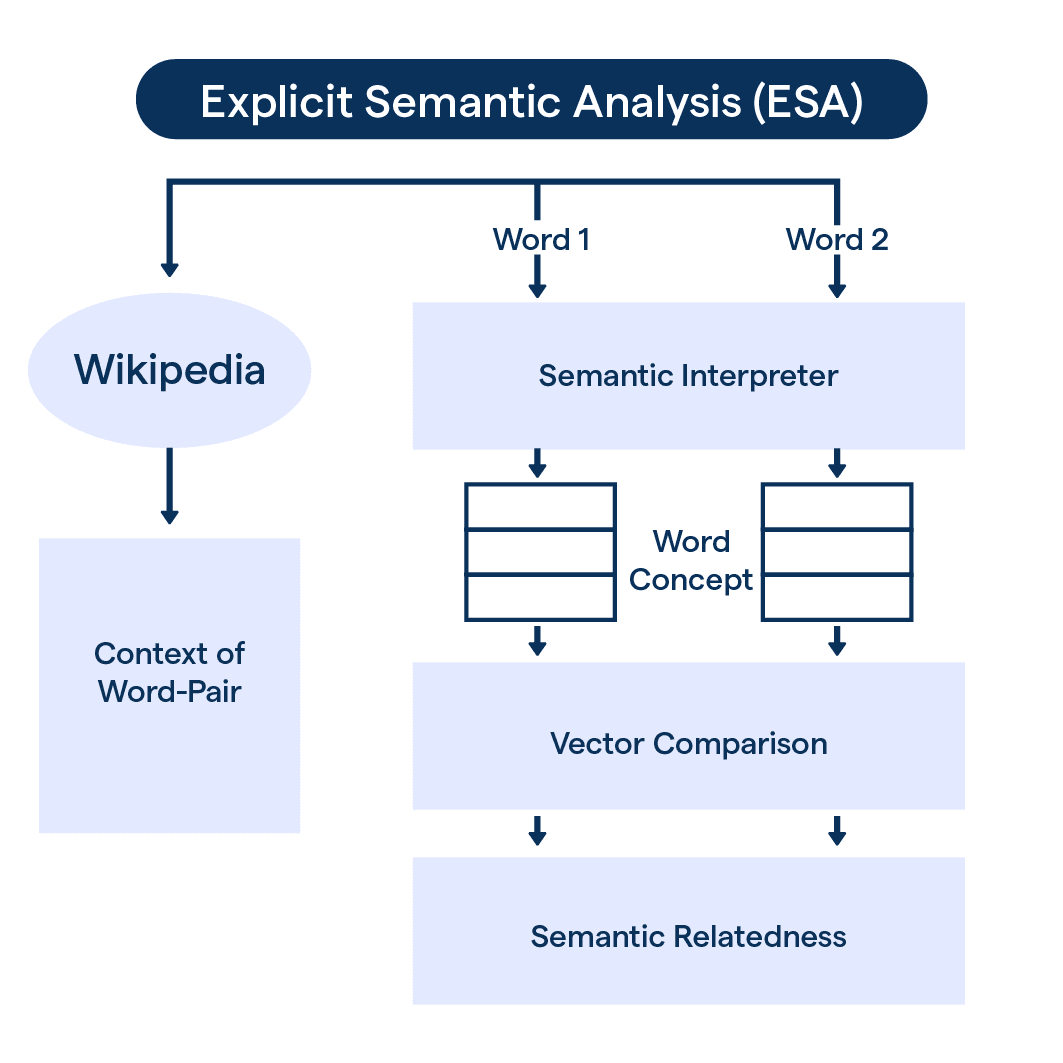What is Explicit Semantic Analysis (ESA)?
ESA, or Explicit Semantic Analysis, is a technique in natural language processing (NLP) that aims to understand the meaning of text by analyzing the relationships and similarities between documents. ESA utilizes a Vector Space Model to represent documents as vectors in a multidimensional space, enabling the measurement of semantic similarity.
How Does Explicit Semantic Analysis (ESA) Work?
Explicit Semantic Analysis (ESA) is a method used to determine semantic similarity between words or texts. It measures how closely related two pieces of text are by analyzing their content and context, using a large corpus of documents to define the meaning of the text.
The Mechanics of ESA
ESA uses a mathematical approach to analyze texts, translating words into vectors based on their context within the corpus. These vectors are then compared to determine the degree of similarity between the two texts.
Concept Vectors in ESA
In ESA, each text is represented as a "concept vector." This vector is created by mapping each word or phrase in the text to a corresponding concept in the corpus. The more frequently a concept appears in the text, the higher its weight in the vector.
Evaluating Similarity with ESA
To evaluate the semantic similarity between two texts, ESA compares their corresponding concept vectors. This process involves calculating the cosine of the angle between the two vectors. The closer the cosine value is to 1, the more semantically similar the texts are.
The power of ESA
ESA has extensive applications, particularly in text-based information retrieval systems, natural language processing tasks, and AI models for understanding human language. It's a powerful tool in the world of data analytics and machine learning.
Advantages of ESA
ESA brings numerous advantages to NLP tasks. It enables better information retrieval, enhances question answering systems, improves text classification accuracy, and aids in discovering semantic relationships within document collections. ESA's ability to capture semantic meaning adds depth and accuracy to various NLP applications.
Limitations of ESA
While ESA offers significant benefits, it is not without limitations. The performance of ESA heavily relies on the quality of the input documents and the suitability of the chosen similarity measures. Additionally, creating accurate and comprehensive document representations can be challenging when dealing with noisy or unstructured text data.
Why Use Explicit Semantic Analysis (ESA)in NLP?
Understanding Semantic Similarities
Explicit Semantic Analysis (ESA) allows NLP models to find semantic similarities between text strings by comparing their context vectors. This can be highly advantageous in applications like content recommendation and document clustering.
Contextual Disambiguation
In NLP tasks, ambiguity often presents significant challenges. Through the use of context vectors, ESA can provide valuable disambiguation, offering insights into the intended meanings of words based on the contexts they appear within.
Improving Information Retrieval
ESA can elevate the effectiveness of information retrieval. When used in search engines or data mining, it enhances the system's ability to deliver high-quality results, making the search function more accurate and contextually relevant.
Enhancing Text Classification
ESA can add value to text classification algorithms. It can improve the accuracy of sentiment analysis, spam detection, and topic labeling, providing more nuanced insights into the data.
Optimizing Multilingual NLP
ESA is highly effective in multilingual environments and can be used to create multilingual semantic spaces. This makes it a handy tool for tasks like multilingual document categorization or cross-lingual document retrieval.
Where can Explicit Semantic Analysis (ESA) be Applied?
Text Categorization
Explicit Semantic Analysis (ESA) can be used in text categorization to accurately classify documents based on their semantic content. By using concept vectors derived from extensive knowledge bases, ESA can identify subtle semantic relationships, making it excellent for complex categorization tasks.
Information Retrieval
ESA plays a critical role in information retrieval systems. It allows for the comparison of user queries and documents in a semantically enriched space, improving the relevance and precision of search results and providing context-aware text matching.
Sentiment Analysis
ESA can be applied in sentiment analysis to understand the sentiment, opinion, or emotion expressed in a piece of text. By understanding the semantic context, it can interpret nuanced statements and detect sarcasm or irony, often missed by traditional methods.
Machine Translation
ESA is used in machine translation to create more accurate and contextually correct translations. It uses semantic understanding to capture the meaning and intent of the original text, resulting in translations that reflect the true intent of the source language.
Document Clustering
ESA can be used in document clustering to group documents based on their semantic similarities. By capturing subtle semantic relationships and similarities, it can unearth hidden patterns and create highly accurate and meaningful clusters of documents.
When to Use Explicit Semantic Analysis (ESA)?
ESA is particularly useful in scenarios where the understanding of semantic meaning is critical. Use ESA when building search engines, recommendation systems, sentiment analysis tools, document clustering algorithms, or any application where capturing and analyzing the semantic relationships between documents is paramount.
Who can Benefit from Explicit Semantic Analysis (ESA)?
Artificial Intelligence Developers
AI developers can use Explicit Semantic Analysis (ESA) to enhance the performance of their NLP models. ESA can aid in improving the understanding of language nuances, semantic similarities, and contextual disambiguation.
Data Scientists
Data scientists working with text data can greatly benefit from ESA. It can help refine their algorithms for tasks like text classification, sentiment analysis, and information retrieval, leading to more accurate outputs.
Content Recommendation Platforms
Content recommendation services, such as those used by streaming platforms and online stores, can leverage ESA to refine their suggestions based on a deeper understanding of user preferences and content semantics.
Search Engine Optimizers
SEO professionals can use ESA to better understand content relevance and optimize it accordingly. It aids in understanding phrases and topics that are semantically connected, leading to more effective keyword strategies and content creation.
Multilingual Service Providers
For companies providing multilingual services, ESA can help in tasks like cross-lingual document retrieval and multilingual document categorization, making their services more efficient and accurate across multiple languages.
Key Concepts in Explicit Semantic Analysis (ESA)
Establishing Semantic Similarity
At its core, ESA is designed to calculate the semantic similarity between words or texts. By considering the context and content of each text, ESA can gauge how closely related these texts are based on their meaning and not just their syntactic structure.
Document Corpora as Knowledge Bases
A crucial aspect of ESA is the use of large document corpora as the knowledge base. These collections of documents serve as the foundation for understanding and establishing connections between words and their meanings, which is crucial in determining resemblance in content.
Vector Space Representation
ESA employs a vector space model, encapsulating the meanings of words or texts as high-dimensional vectors. By mathematically transforming content into accurate vector representations, ESA sets the stage for comparing and contrasting different pieces of text.
Cosine Similarity Measurement
For comparing two texts using ESA, the cosine similarity between their respective vectors is calculated. This measurement represents the similarity in angle or direction between the vectors, where a cosine value of 1 indicates near-identical semantic content, and 0 denotes no resemblance.
Wide-Ranging Applications
ESA's versatility and adaptability extend far beyond simple content comparisons, with applications spanning information retrieval systems, natural language processing, content recommendation, and even AI models capable of discerning human language nuances. It is a powerful ally in the world of data analytics and machine learning.
How to Implement ESA?
Define the Problem
The first step to implement Explicit Semantic Analysis (ESA) involves defining the problem you want to solve. Be it sentiment analysis, information retrieval, text similarity analysis, or any other application, having a clear understanding of the problem will guide your implementation process.
Prepare Your Data
Data preparation is crucial in implementing ESA. Your data needs to be cleaned and pre-processed before being fed into the ESA model. This process may involve removing stop words, lemmatization, handling missing data, and ensuring the data is in a format acceptable by the ESA model.
Build the Semantic Space
The next step in ESA implementation involves building the semantic space. In basic terms, this is a high-dimensional space where each dimension represents a unique concept. Typically, this space is built using a large text corpus like Wikipedia. Concepts are derived from the text, and their interrelationships are laid out in the semantic space.
Project Text onto Semantic Space
With your semantic space prepared, you'll need to project your text (document/query) onto this space. This involves transforming your text input into a concept vector in the semantic space. The semantic representation of the text can then be used for further processing.
Apply for the Desired Task
You can now use the resulting semantic representations for your specific application. This could be evaluating text similarity, improving search engine responses, sentiment analysis, and more. The usage depends on your predefined problem and how you've trained your ESA model.
Frequently Asked Questions

What is Explicit Semantic Analysis (ESA)?
ESA is a natural language processing (NLP) technique that derives the semantic meaning of text by analyzing relationships between documents. ESA empowers NLP tasks like information retrieval and text classification.
How does ESA differ from other NLP techniques?
ESA is unique because it uses a multi-dimensional vector space model to represent documents. This allows for accurate measurement of semantic similarity, whereas other techniques often rely on simpler models or word-level approaches.
What are some applications of ESA?
ESA is advantageous in verticals like search engines, recommendation systems, sentiment analysis, document clustering, and information retrieval. With its ability to capture semantic relationships, ESA provides more effective and relevant results.
Are there any limitations to using ESA?
The performance of ESA relies heavily on the quality of the input documents and the suitability of the chosen similarity measures. Accurately representing noisy or unstructured textual data can also present challenges.
How is ESA implemented in NLP projects?
To implement ESA in NLP projects, documents are preprocessed and tokenized, term frequencies calculated, vector models built, and similarity measures applied. Frameworks like spaCy, gensim, or scikit-learn can assist in the process.

